As I remember it, I was eating a hot fudge sundae with my grandmother at a local ice cream fountain. It was an odd little 1950’s leftover, the kind of fountain that doesn’t really exist any more in these parts. My grandmother would park her Corvair behind the shop and we’d enter, like any of the regulars, through a creaky back screen door. We’d sit at the metal edged counter on spinning stools (well, mine was spinning) or in a sturdy vinyl booth, which was sometimes sticky from the previous patrons or if freshly wiped down, sometimes offered a top note of sweet, old milk mixed with bleach. The older couple that worked the counter still wore their uniforms, a hair net for the woman, a funny hat for the man. On this particular day we were in a booth, just the two of us, and my grandmother decided to let me in on one of her little secrets about that ice cream fountain–one that I will never forget.
She leaned in and told me the most colorful story, of which there must have been a lot of explaining to do on her part. My grandmother, apparently, had a very brief, wild period of frequenting a local speakeasy while in early high school. Her boyfriend at the time, not my grandfather, Knew Someone Who Knew Someone and the young couple were able to gain entrance into this forbidden club. And the shocker was that this speakeasy had been in the very block of businesses that this ice cream fountain was in. In memory, it might have even been in that very ice cream shop. I’ve already told you I would never forget and here I am having already forgotten that important fact. What I remember of the story was something of a Special Knock, a sliding peephole in the door (sometimes called a Judas Hole or Judas Window, from old detective novels), a password, followed by the teenage pair being shuffled down a very long hallway, only to walk out into a small, but densely filled smoky room. Adults drinking and smoking to their collective hearts’ content. The elephant’s knees! She must have thought it felt very Big City. I have since estimated that this must have been about 1932. The bar inside was quite shallow, offering only the essentials in liquor and likewise, only a few men worked there–most likely one bartender, a couple of henchmen and one at the Judas Hole. It was dark and windowless, a room within rooms. It was there that she learned to drink a Sloe Gin Fizz and took up smoking cigarettes. The complexity of the Prohibition Era aside, I could not really understand, at my young age, what any of this meant.
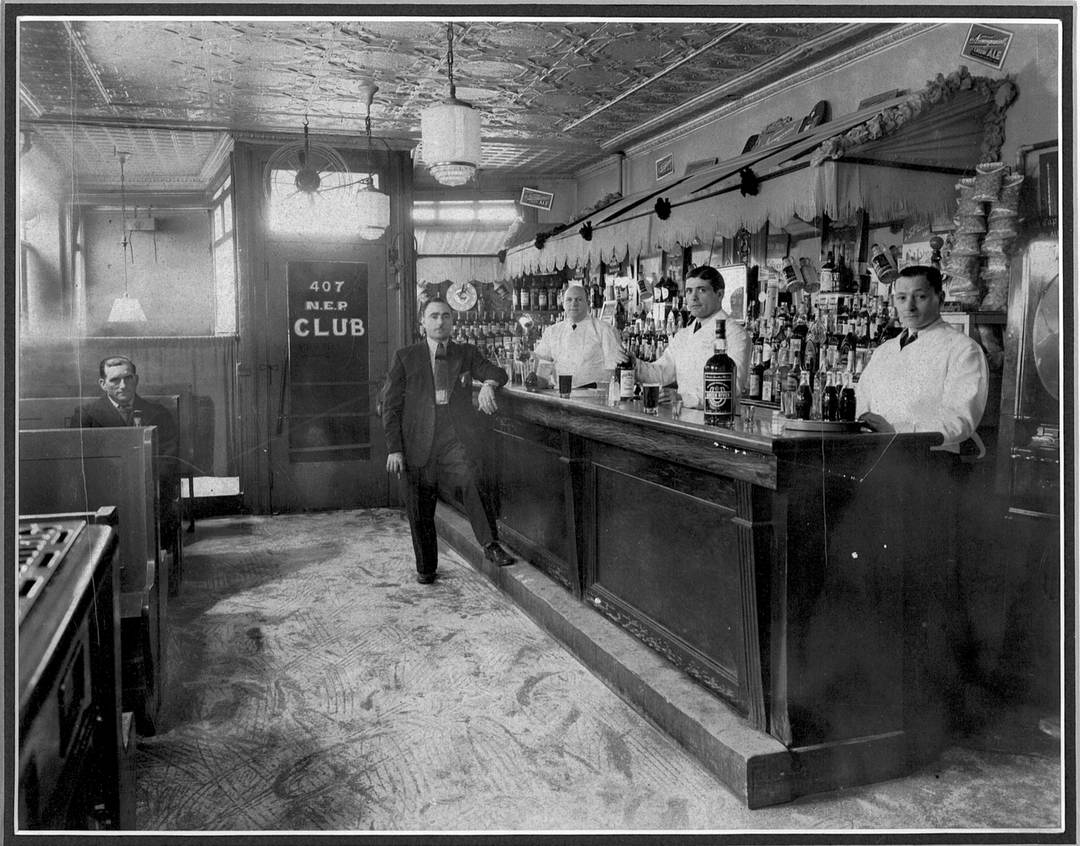
This little bar, albeit, from a 1934 East Coast cafe, illustrates fairly well what my grandmother had described of the speakeasy, save for the windows. Not much to look at, elbow room only, saw-dusted floor, complete with a slender bar, the sole purpose of serving that much in demand alcohol.
We would talk about her very limited but memorable encounters with the speakeasy underworld, as I got older. I asked even more questions as my understanding of the early 1930’s grew. I assure you, her experiences were all very innocent but she might have left out the necking parts. So the story goes, my grandmother’s father, a well-known businessman in town, put a stop to these teenage escapades in no time short. Seemingly, a number of his associates tipped him off. Of course this made my grandmother mad to no end as these reputed esteemed colleagues had been indulging in the illegal drink and were no doubt “blottoed on hooch” themselves. I am sure it wasn’t a very pleasant exchange.
I was reminded of this whole account very recently when I began reading Omaha: A Guide to the City and Environs. This incredible book was written from 1935 through 1939 as part of the American Guide Series, written by members of the Federal Writers’ Project of the Works Progress Administration. The books and brochures of this series initially gave useful employment to unemployed American writers and research workers during a difficult time in US history. But what developed was an amazing, ambitious project of large scale, where writers, editors, fact checkers, historical societies, librarians, journalists, postal workers, and field workers began to compile a portrait of America, town by town. Apparently every larger city has a book. The Omaha book is outstanding, as told by field workers who walked block by block documenting the buildings in what they called “tours.”
It was in the reading of this, at times, funny document that I came across a very short vignette that both aroused my ever-operative curiosity and would later remind me of my grandmother’s juicejoint exploits. The words read, “The CLOVER LEAF CLUB, in the basement at 119 S. 15th St., was opened in 1932. A dine-and-dance grotto, it was for several years a famed resort of night-life in Omaha.” I was hooked. And I may be getting ahead of myself but I kid you not, someone long ago had written in faded pencil alongside that passage, the ^ symbol and “Snooky.” I don’t know why it happened but that stylized script, that little clue from long ago, sent me off and running. This is the story of my adventures in tracking the famous Clover Leaf Club and the secrets buried deep under an Omaha high-rise.
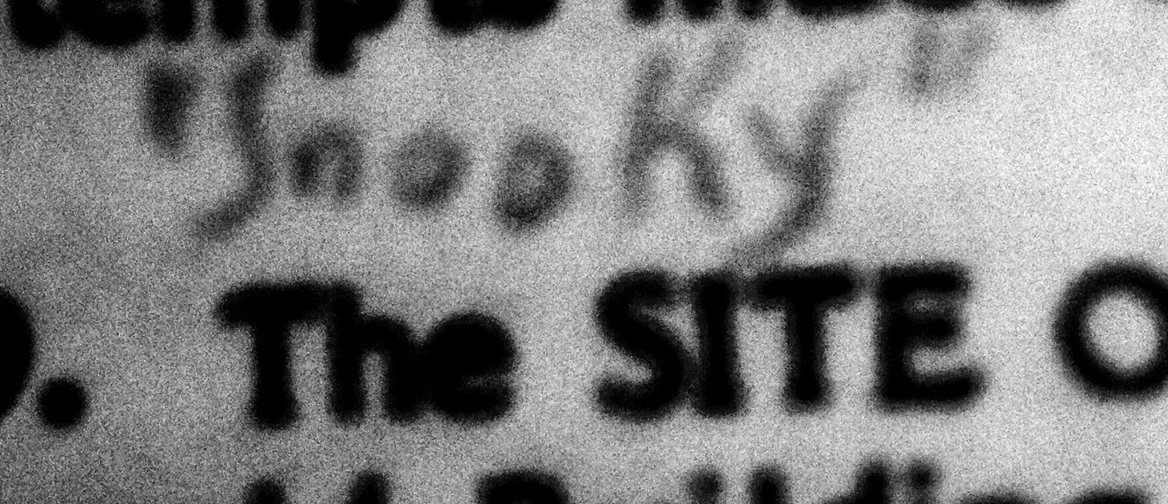
The Early Search for the Clover Leaf Club and Some Diversions

2016 map
With my Federal Writers’ book as a pointer, I began looking into the site of the Clover Leaf Club: 119 S. 15th Street. I quickly found that this address no longer existed but established the club would have been on the northeast corner of 15th and Douglas, midway between Dodge and Douglas. Douglas Street, which runs east and west, is one block south of Dodge. From M. B. Newton’s book, Anecdotes of Omaha, I discovered Douglas Street was named in honor of Stephen A. Douglas, the “little giant” of Illinois, who as U.S. senator worked for the bill to authorize the building of the Union Pacific Railroad. In fact the Clover Leaf Club address is now the site of the Union Pacific Center, a full city block at 1400 Douglas Street. Within the Center, the UP also has their credit union, carrying a S. 15th Street address. Check out another Douglas Street mystery I traced in Mysteries of Omaha: 2561 Douglas Street.

Union Pacific Center from Dodge to Douglas, 14th to 15th.
This whole four-block area of downtown is quite different from my high school years. A historic aerial view of the nearby plats, courtesy of the GIS portal (thanks to Omaha librarian, Mark, for sharing this site with me) shows such an amazing transformation from 1941 to 2016.
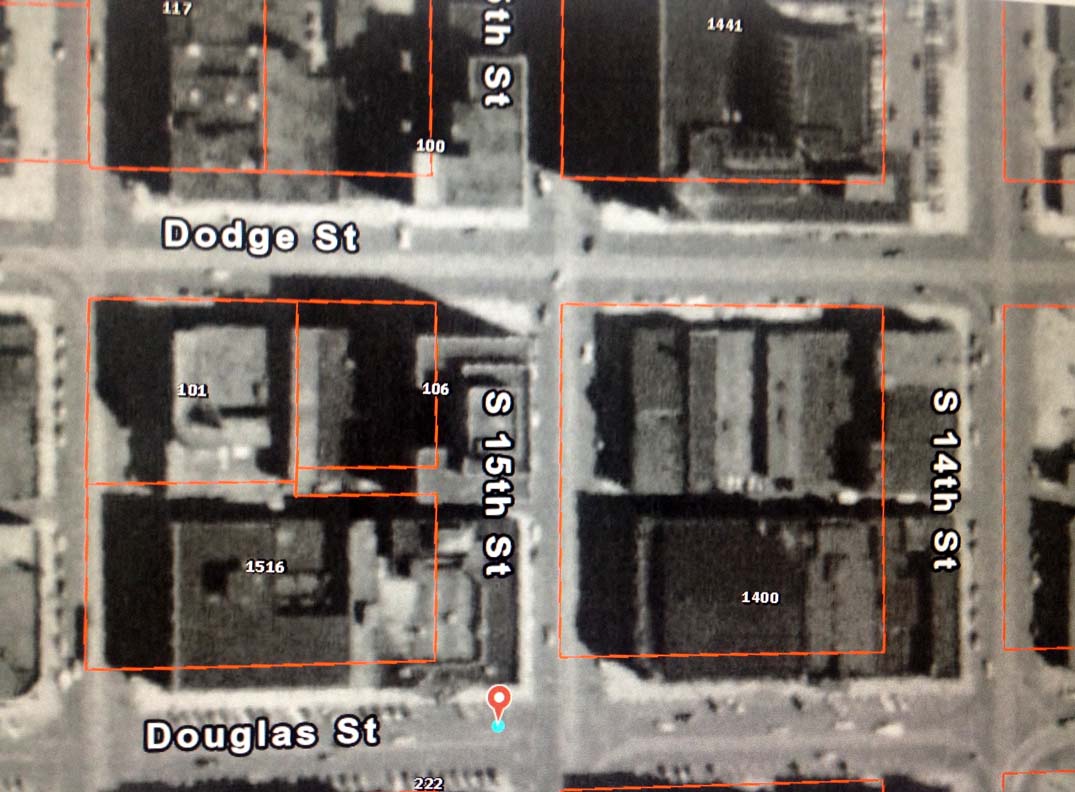
1941 GIS portal map

1993 GIS portal map
In my quest to trace the lay of the land at the time of the Clover Leaf, I looked to the one building that still resides in the area. Just northwest of what would have been the Clover Leaf is currently the Marriott’s Residence Inn at 106 S. 15th St. My whole life this was known as the Federal Office Building or the Old Federal Building. This became a hotel just a few years ago. If you haven’t been in this Art Deco cutie, go walk through the hospitality rooms on the main floor. Amazing bones and the staff is all very welcoming.
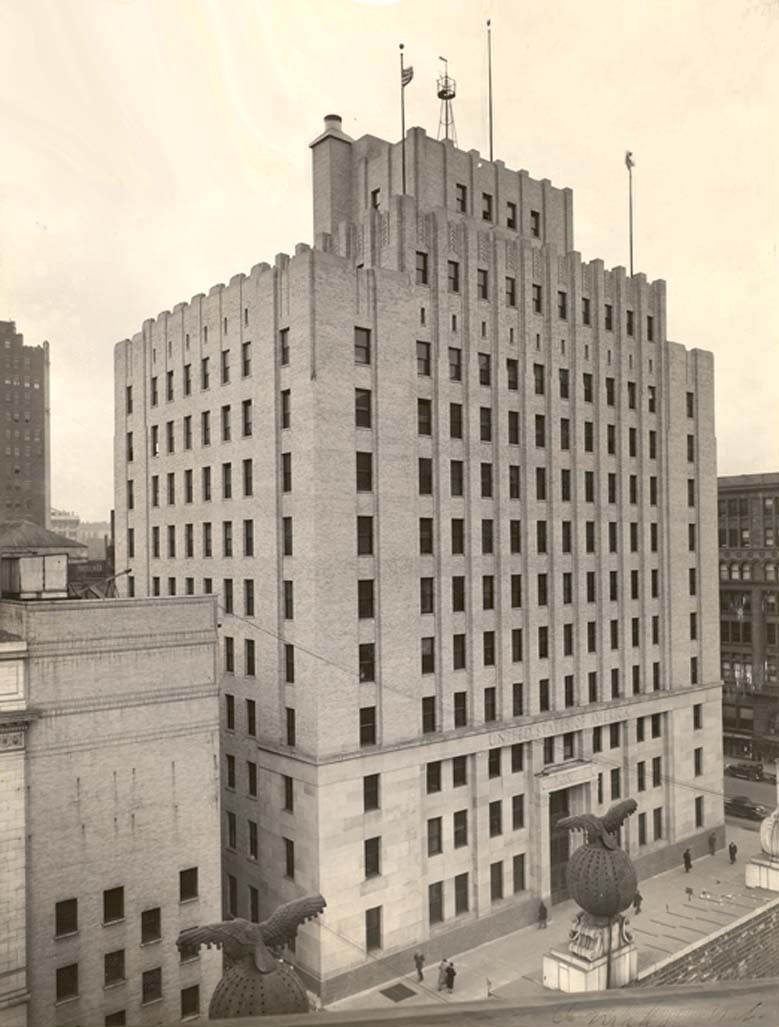
Photo of the Old Federal Building, when it was originally erected in 1934.
Directly across 15th Street from the current Union Pacific Center is the hideous but I suppose, grudgingly needed Park One parking garage at 1516 Douglas. This was built in the early 1980s. I uncovered some essential clues that further established the time period and cultural environs of the neighboring Clover Leaf Club. The World Theater had proudly stood on this corner from 1922 until the mid 1930s, one the many glorious theaters in downtown Omaha. This glazed terra cotta marvel must have been such an impressive structure, boasting round arched windows and Corinthian columns. The center of the building and upper three floors was the theater with ground level shops surrounding it. What a knock out.
 The World Theater in 1927, “cooled by frosty air.”
The World Theater in 1927, “cooled by frosty air.”
The theater had changed its name in 1935, to the Omaha Theater. They continued to show movies with some live performances. By 1978 it was closed and later demolished in 1980. I was too young to have remembered this one but I’d like to think I saw it. One of the many blocks that I surely passed by that gave me the impression of the sheer glory of old Downtown Omaha. Check out this phenomenal site for more on the World-Omaha Theater: http://cinematreasures.org/theaters/1210.
 Omaha Park One parking garage as it appears today.
Omaha Park One parking garage as it appears today.
Soon after I found a fabulous photo by Larry Ferguson, taken in 1978 or 1979 of the corner of 15th and Douglas. It clearly depicts the last days of the forlorn Omaha Theater (although I’ve heard people fought to save her) and also shows the emptied ground floor shops. I stumbled upon this in my library of Omaha books, this particular one, an amazing collection called Yesterday & Today by Kristine Gerber and Tom Kessler. In studying this photo I unearthed what would have been the entrance to the Clover Leaf Club (building on the right), although surely long gone by the late 1970s. This original building that housed 119 S. 15th appeared to be quite impressive, as well. I was so excited.
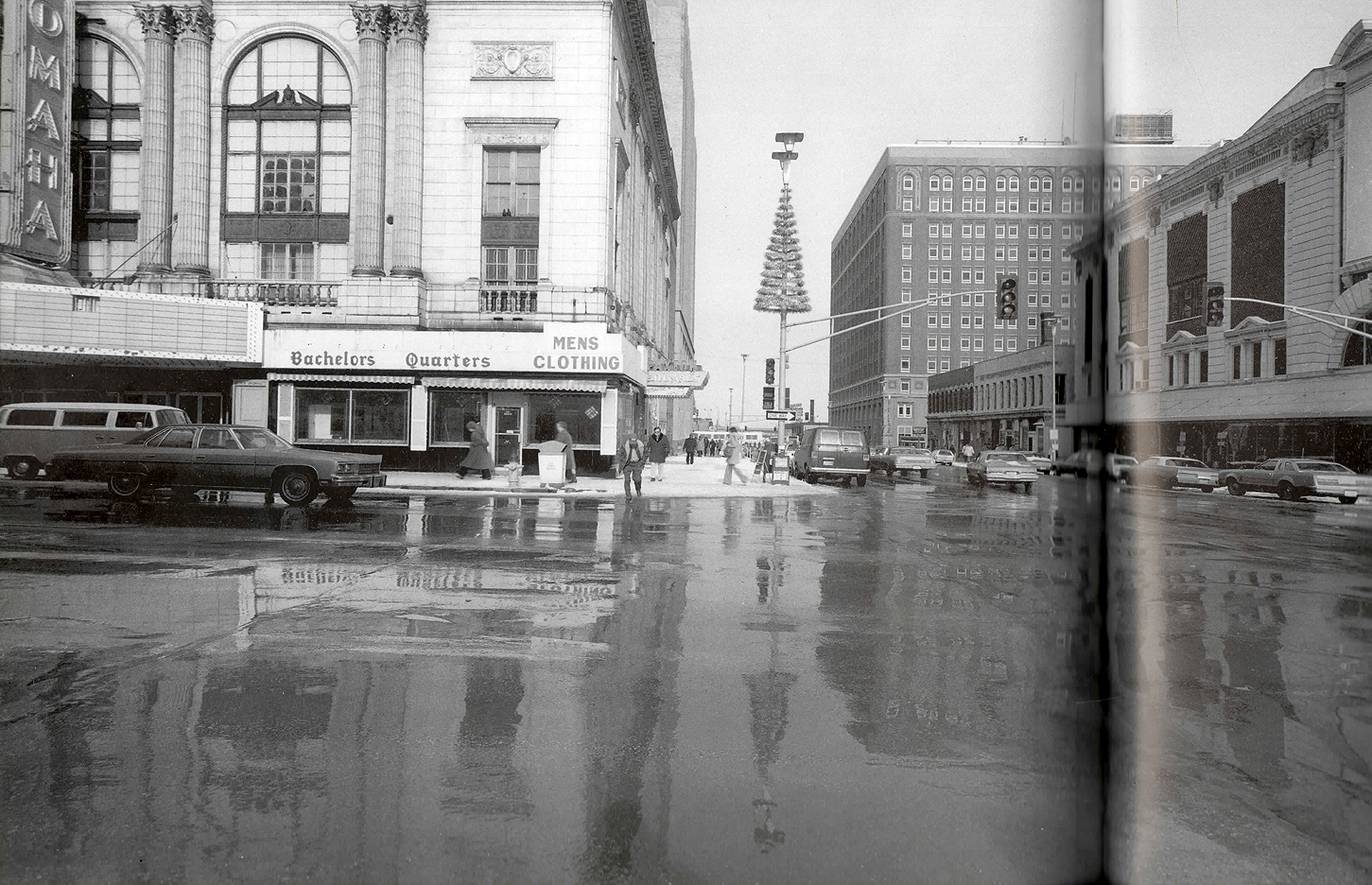 Larry Ferguson’s photo from 1978. (Photo courtesy of the Larry Ferguson Photography Collection.) Check out his work at http://www.fergusonstudio.com/
Larry Ferguson’s photo from 1978. (Photo courtesy of the Larry Ferguson Photography Collection.) Check out his work at http://www.fergusonstudio.com/
Side Mystery: I must also mention that in the surveying and salivating of this photo, I spied in the background the location of my dear friends’ luncheonette. For those of you who had the pleasure of eating at Rob Gilmer and Rene Orduna’s Dixie Quicks Luncheonette on 15th and Dodge in the 1990s, feast your eyes. If you haven’t been, for the love of Lydia, please check out http://dixiequicks.com/. The Frenzer Block that was home to Dixie Quicks, among other businesses, was demolished in 2001.
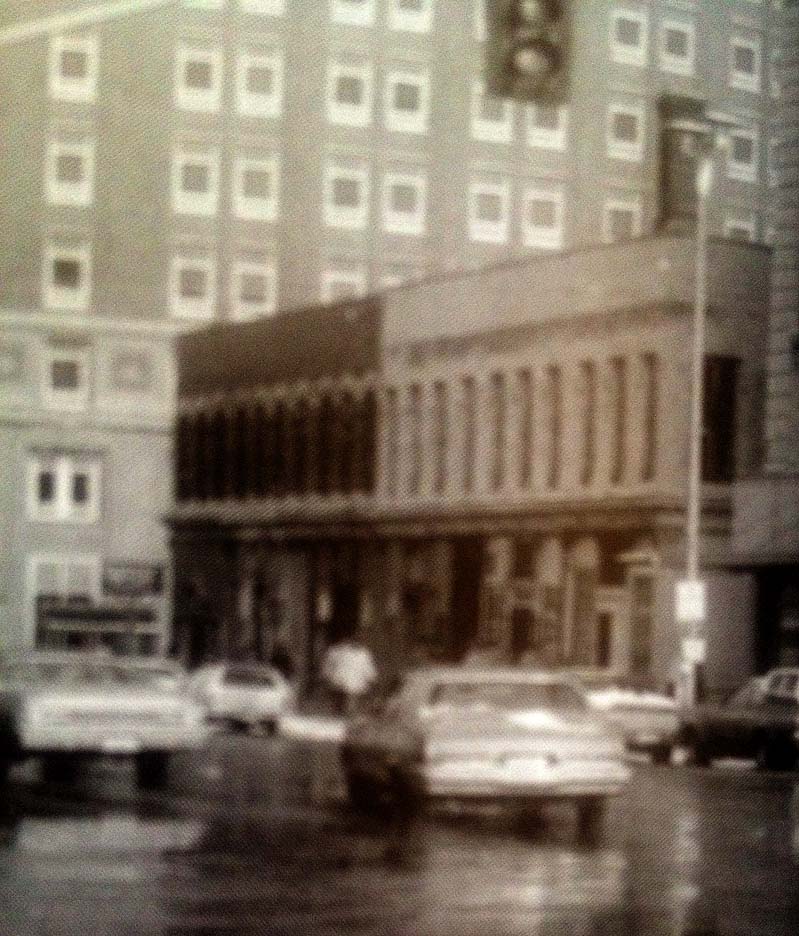 Detail of Dixie Quicks from the late 1970s. Yes, I realize Dixie Quicks wasn’t born yet. In the early 2000s the restaurant would later move to 1915 Leavenworth St. and currently is located in the historic Council Bluffs area at 157 West Broadway.
Detail of Dixie Quicks from the late 1970s. Yes, I realize Dixie Quicks wasn’t born yet. In the early 2000s the restaurant would later move to 1915 Leavenworth St. and currently is located in the historic Council Bluffs area at 157 West Broadway.
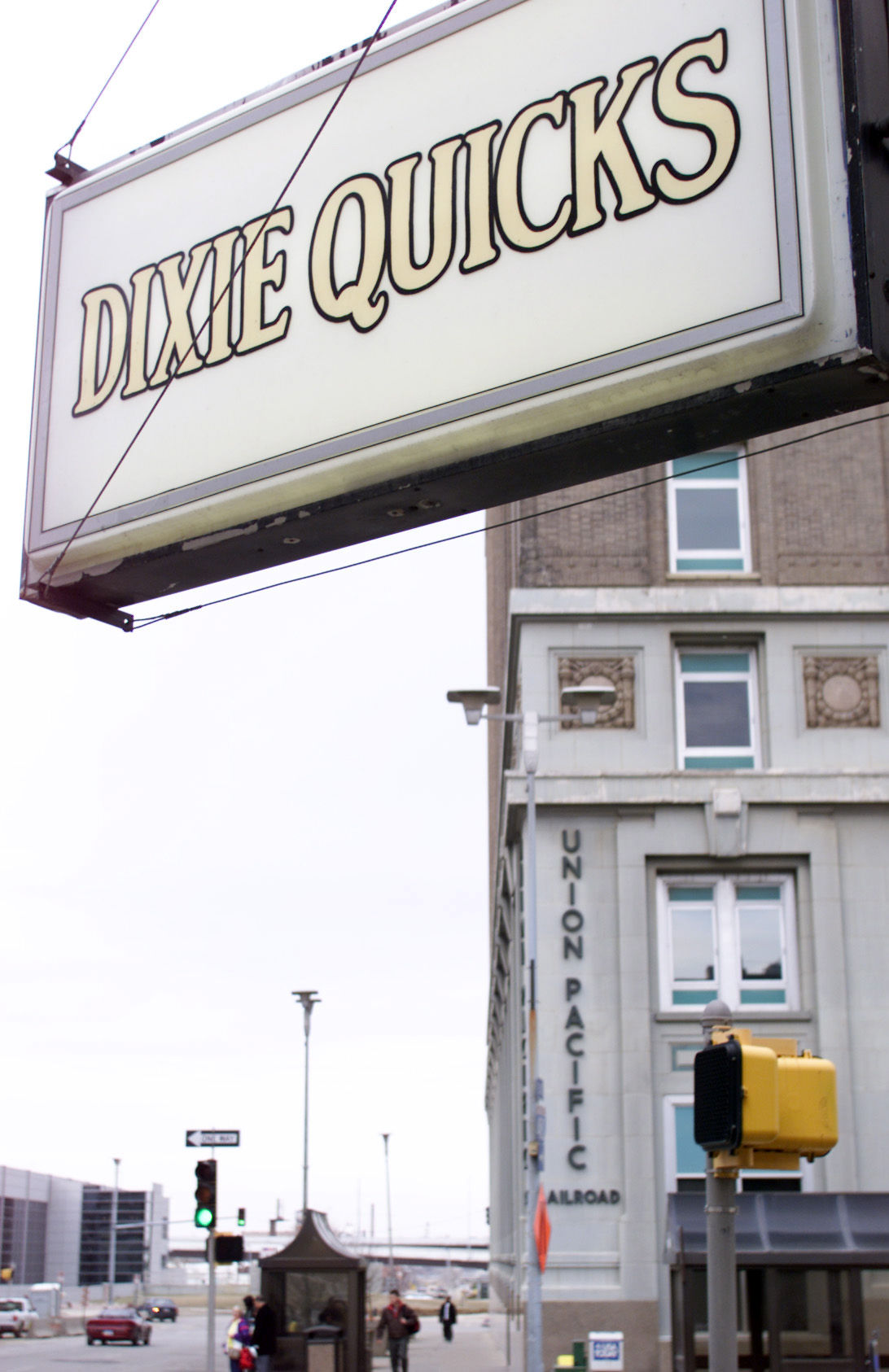
Great photo by Laura Inns. (If you know Laura can you let her know I have written her about seeking permission to use this photo and would love to hear from her.) Remember the incredible Dixie Quicks’ sign? A little more evidence: the Union Pacific headquarters as seen in the background was also demolished in 2008.
The 1424 Douglas Clue
The Yesterday & Today book gave me an early piece of evidence that was much needed in this case. A tip off to the old Rialto Theater sent me tracking a new puzzle. The Rialto Theater was one of the numerous, well-attended movie theaters in Downtown Omaha. At 1424 Douglas Street, the Rialto was in fact, right across 15th Street from the World Theater. Much like the design of the World, the Rialto was a large movie house, with plenty of room for an orchestra space, a diagonal corner entrance with three arches, storefronts along the street level with an exterior of ivory and terra cotta. This huge, stately building opened in 1918 and was quite a success.
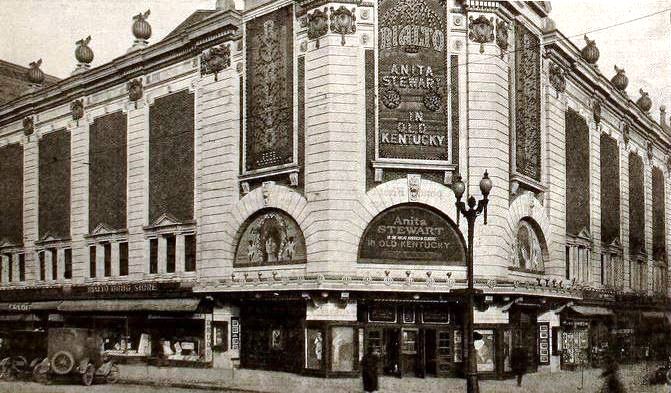 The Rialto Theater in 1919.
The Rialto Theater in 1919.
By 1929 the Rialto Theater suddenly closed (the Great Depression?) and was divided, in time, into additional retail shops. In June of 1930 the Pickwick Greyhound Lines was unveiled as an ever-growing mode of public transport. By 1934, intercity bus lines carried almost as many passengers as the railroads. The hit film, It Happened One Night, where an heiress was featured for the first time traveling by Greyhound bus, is credited with making bus travel au courant.
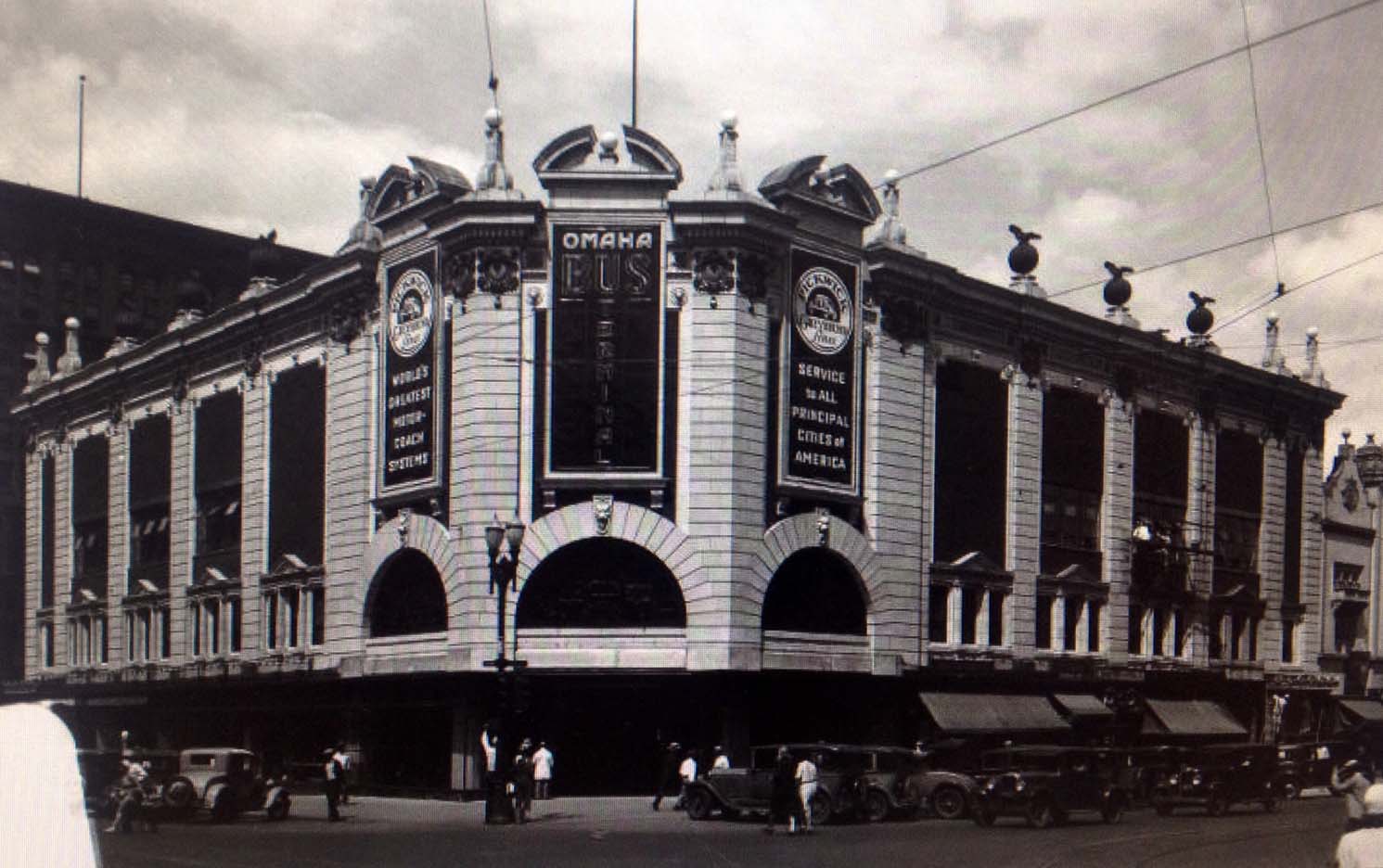 June 30, 1930 Exterior of Pickwick Greyhound Lines at 1424 Douglas. (Photo courtesy of the Bostwick-Frohardt/KM3TV Photography Collection at The Durham Museum Photo Archive).
June 30, 1930 Exterior of Pickwick Greyhound Lines at 1424 Douglas. (Photo courtesy of the Bostwick-Frohardt/KM3TV Photography Collection at The Durham Museum Photo Archive).
Obscured Beginnings
The Clover Leaf Club, the famed resort of nightlife in Downtown Omaha, was said to have opened in the basement in of the Pickwick Greyhound Lines in 1932. By examining the city directory of 1932 I could find no listing of the establishment, instead finding it listed as “vacant.” Later I found 119 S. 15th Street mentioned in the Omaha World Herald of 1932 as being home to Jack Guthrie Cigars. The youth sleuth in me became both suspicious and intrigued by this cigar store, considering the time period in America. I began to wonder about the “cigar store” link to, perhaps, illegal alcohol and gambling. Not to say that Jack Guthrie Cigars was not a fine, upstanding establishment. I could only find mention of it once.
Let’s briefly review what was happening in this time period. From 1920 to 1933 there was a nationwide constitutional ban on the production, importation, transportation and sale of alcoholic beverages. Note consumption is not mentioned. Under the Eighteenth Amendment to the US Constitution in 1920, movement by the Progressives, moral groups, Prohibition supporters or“drys” was made legal. It is interesting to note that religious uses of wine were allowed. Additionally federal law did not prohibit the private ownership and consumption of alcohol but in many areas, local laws were stricter. The Twenty-first Amendment, which repealed the Eighteenth Amendment, lifted the ban on production and sale of alcohol on December 5, 1933. There were some states that continued the ban. Omaha was not one of them. Omaha was known as a “wet” city, compared to “dry” Nebraska. By appearances, Omaha only paid lip service to the Eighteenth Amendment with hundreds upon hundreds of bars still in operation during this thirteen-year period. Check out this fantastic bit of Omaha history. http://www.omaha.com/go/prohibition-and-nebraska-in-a-largely-dry-state-omaha-wanted/article_771d36e9-afbf-554c-bd0f-4f8dee162274.html

Disposing of Alcohol During Prohibition, surely after a bust, 1930s.
Likewise, during Prohibition, Omaha’s wide array of cigar stores were actually operating bookie joints. The cigar store was the place to stop in and play cards, bet on a game, the horses or a big fight and Everyone Knew It. Placing bets and bookmaking operations through cigar stores and billiard parlors were a steady practice for a good number of Omahans.
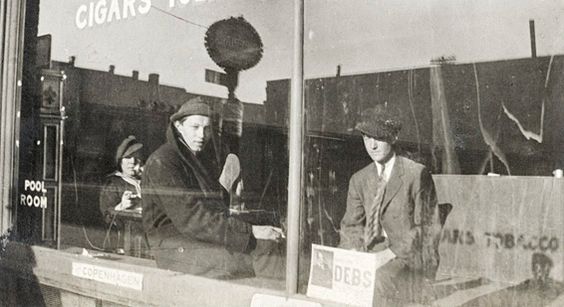
Cigar store patrons looking for fun in the afternoon.
So taking this bit of history into account, let us proceed further. My second encounter with the 119 S. 15th Street address was when I chanced upon this smart advertisement from January 22, 1932.
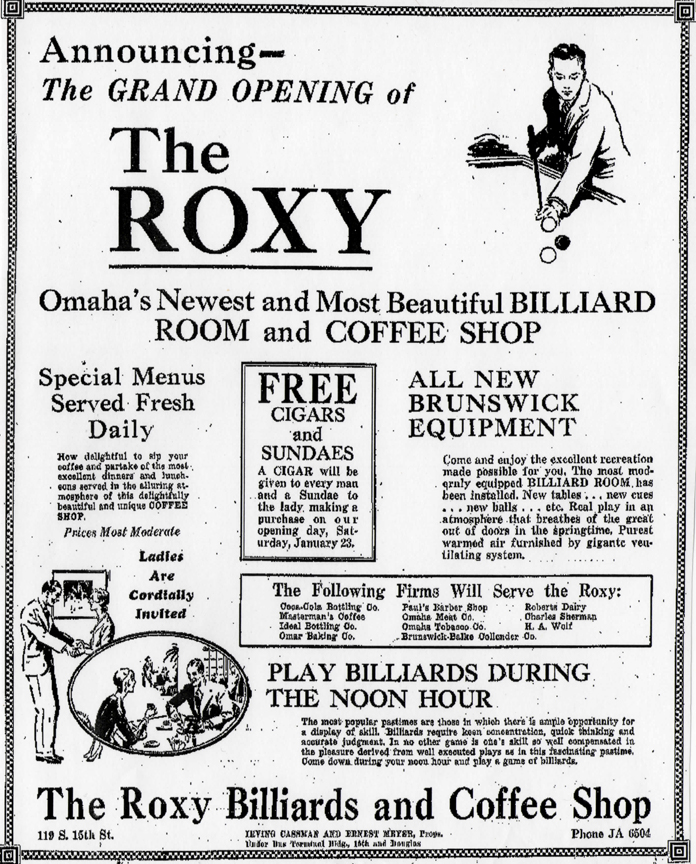
January 22, 1932 The Roxy Club. I love everything about this print ad. What’s playing at the Roxy? I’ll tell you what’s playing at the Roxy!
I was a bit uncertain of my chosen path to the Clover Leaf Club until I discovered this fantastic little commendation from July 23, 1933 Omaha World Herald. I finally had my solid piece of evidence for the Clover Leaf Club.

July 23, 1933 “Here’s Relief” The pause that refreshes!
Upon reading that the Clover Leaf Club was cool (read: Air Conditioning–this was a big deal in the early 1930’s!) and decorated like a forest glen, I knew I needed to know more. My mind was spinning. A Forest Glen. I had never heard of anything so dreamy. I had already envisioned it to be a basement “dine-and-dance grotto” from the previous reading. This meant, to me, that amid the Downtown Omaha buildings, the Clover Leaf Club was a chilled, cavern-like lounge bedecked with foliage and trees. I began to look into this club concept and as it turns out, there were countless hep clubs throughout America enhancing with forest glen style interiors during this period. Who knew? In these years there were also numerous underground clubs called “grottos.” These grottos usually indicated a club was in a basement or an underground lower level. As you can imagine this experience of descending stairs or use of an elevator lent itself to a natural, cave-like theme. I was reminded of visits to my grandmother’s family friends in very early childhood. This couple, who coincidentally lived very close to the Black Angel, had built grotto-like walls and shelving in their basement—a vestige to the elderly couple’s 1930s rumpus room days. The cement of the walls was chock-full of shells and stones from their worldly travels. I remember there being colorful lights in the shelving. Both haunting and mesmerizing, I can only compare it seeing Mr. C’s awe-inspiring décor for the first time. Or third visit.
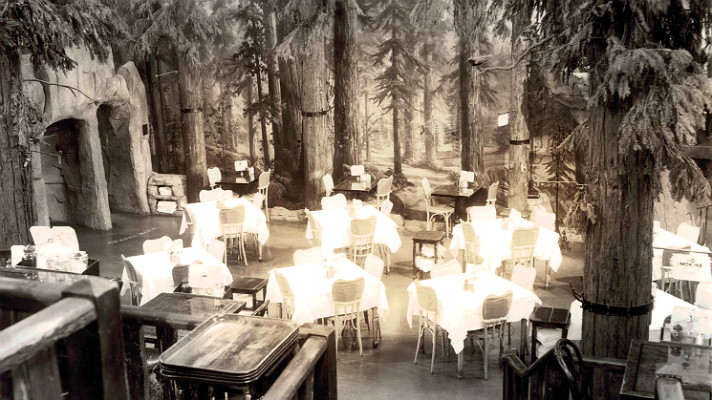
Forest glen interior example from a Los Angeles nightclub of the early 1930s. Dying. Take me there right now.
By 1933 I found a clear listing for the Clover Leaf Club in the city directory. I also found the photo below, which shows a daylight accident outside of the club. Signs on the storefront read “Tully’s The Hatter” and “Stetson Hats.” Tully’s offered “the best” in men’s furnishings. There appears to be a pharmacy on the left and there….there it is—The fabulous Clover Leaf Club sign above the door.
 1933 Firemen and fire equipment parked in front of Tully’s on 15th and Douglas Street. Signs on the storefront read ” Tully’s The Hatter”and “Stetson Hats.”(Photo courtesy of the John Savage Photography Collection at The Durham Museum Photo Archive).
1933 Firemen and fire equipment parked in front of Tully’s on 15th and Douglas Street. Signs on the storefront read ” Tully’s The Hatter”and “Stetson Hats.”(Photo courtesy of the John Savage Photography Collection at The Durham Museum Photo Archive).
Making History
The Clover Leaf Club was gaining notoriety as one of the swankiest spots in the city. By all accounts, it was the cat’s whiskers. The previously repressive drinking laws lead to the development of these themed nightclubs. Typically they opened late as other dance clubs and “the pictures,” meaning movies, were letting out, attracting many owls off the streets. Miss Cassette’s favorite time period for fashion is the 1930s and 1940s and I love to daydream of what the guys and gals must have worn to the Clover Leaf Club. I located a great little article from the OWH, dated November 9, 1933. In it Hubert McGhee, former waiter at the Clover Leaf Club, sued Frank Hart and Frank Yousem, proprietors of the club, for $10,000. McGhee charged that he was “falsely arrested.” McGhee also alleged that his boss, Hart, drew a revolver while questioning him and struck him. This was my first indication that all was not well at the Clover Leaf Club.
Dancing was very popular in the 1930s. Not only were there scores of Omaha venues offering dancing during the week, many operated most nights of the week. And there were a large number of dancing classes advertised as well. At this time everyone was doing the Tango, the Maxina, the Varsity Drag and Stamp, Jazz Waltz and Drag Tap. There were also advertisements that mentioned the Rumba, Quickstep Waltz, Slow Fox Trot and Old Style Dances. And the music? Miss Cassette’s absolute favorite time period for music. The Clover Leaf Club was known for their bands and orchestras, dancing, lunch and dinner, soft drinks, hard liquor and apparently, gambling. I began to wonder if it had always been a gambling establishment, seeing as the cloverleaf is one symbol on a deck of cards. By 1935 the Clover Leaf Club was being raided frequently by officers, looking to comb through and ransack the premises.

Listing of other neighboring local businesses at the time.
I uncovered a fascinating article from the OWH, dated May of 1935. There had been a recent Clover Leaf Club gambling raid where seven men were arrested. Three men were held for trail: Ike Levinson, George “Dutch” Volker and Fred Sellers, all living at the Loyal Hotel. Five other men were dismissed for playing a game of chance with two others being fined $5 each. Apparently the raid followed after two patrons turned in the Clover Leaf for offering games of chance. The officers who conducted the raid reported, “When they entered, Volker ordered Sellers to press a signal light which warned players in the rear room. Levinson denied it was a signal light, saying it was meant to summon the porter. The back room was not for gambling but a dressing room for musicians, he said.” Levinson denied there had ever been gambling in the Clover Leaf Club. The proprietors were listed as Ike Levinson, Dutch Volker and one Charles Hutter.
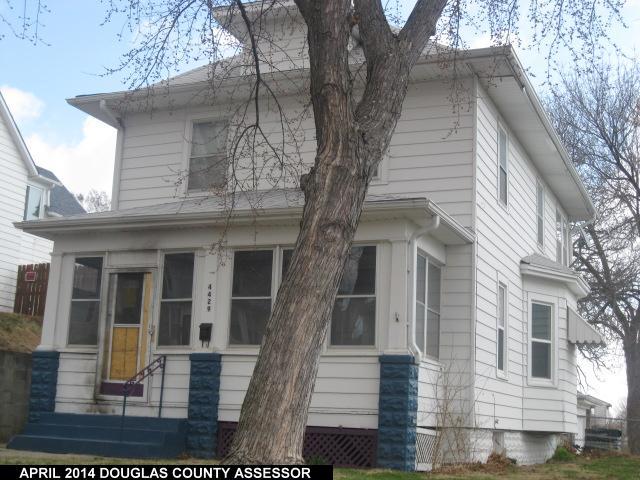
The famous Hutter home, built in 1920. It’s still standing at 4429 South 18th Street. If walls could talk… has never been a more appropriate euphemism.
I would find endless reports on Charles Hutter Sr. from the Omaha papers. As it was revealed to me, Charles Hutter had been a sheriff in Sarpy County in the teens and by the turn of 1920 Prohibition, Hutter had joined in the bootlegging business. Big Time. He quickly became one of the three main bootlegging operators in these parts. Hutter would be arrested countless times due to sting operations. He was accused of having ties to Al Capone and the Chicago syndicate. One of the many highlights of these never ending series of articles was the story of Charles Hutter being shot. Hutter reported to being shot in a stick up in front of his home at 4429 South 18th Street. (I found through some digging that Lloyd Hutter, a clerk at Paxton and Gallagher also lived there, as did Marcus, his brother, a city fireman, and Tillie Hutter.) Charles Hutter was shot in his leg a number of times on this particular 1931 night, leading to him losing his left leg at the knee. His son, Charles Hutter Jr., also backed up his father’s story but the police were not buying it. They believed this was an assassination attempt in a bootlegger’s war. From what I could find, Charles Hutter Sr. and Dutch Volker became involved in these early years.
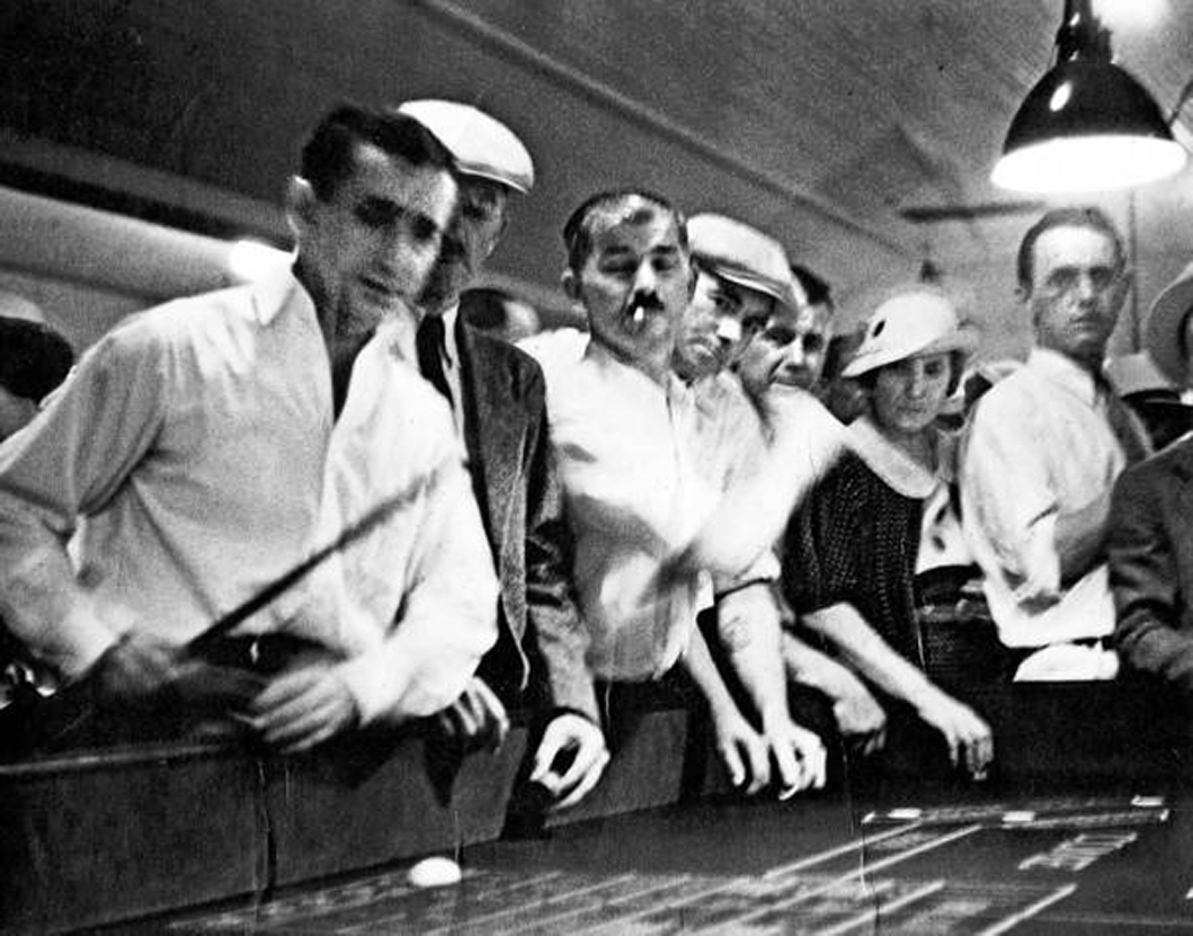
This incredible 1935 photo, shot surreptitiously by a Tribune photographer, illustrates gamblers of this time period who filled the Dev-Lin casino.
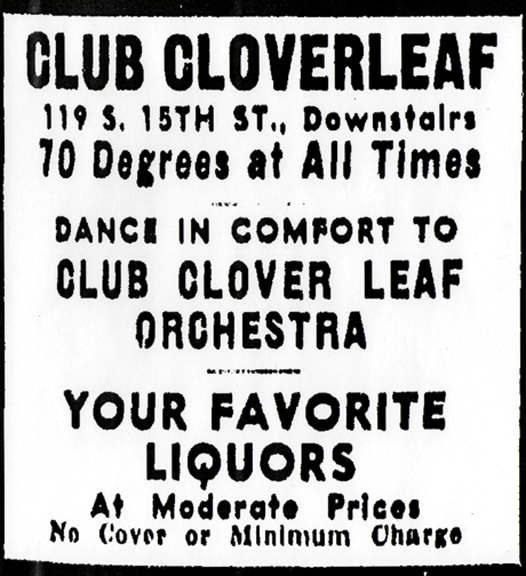
From July 20, 1935 always 70 degrees. Miss Cassette approves of this message.
In July of 1935 the Clover Leaf Club was approved of their application for sale by the drink. —More Omaha businesses given licenses to sell liquor—state liquor commission issued 26 retail package liquor licenses and approved 24 applications for sale by the drink. Dutch Volker, owner, was again arrested in October of 1935 for violating a city ordinance prohibiting the “serving of whiskey after midnight.” Apparently when the patrolmen walked into the club, he was “razzed by Volker, who shouted ‘no rookie cop is going to prevent me from serving liquor to my friend.’” Can you imagine the shout of cheers from his patrons? That rascal. I was getting swept away by these characters.
And what characters these fellows must have been. Dutch Volker would go on to argue that the club’s city restaurant permit gave him the right to operate exclusively as a restaurant after two a.m. Ads at the time highlighted “no cover charge” and dancing to “Bill McKenna’s Orchestra every noon and night. Your favorite drink at reduced price.” Another name I love was advertised as “Dance to Synco Hi-Hatters Orchestra.” In yet another colorful article from 1935, a patron was apparently locked in the Clover Leaf Club accidentally when it closed. He fought and bit officers who came to let him out, leading to him being held and investigated.
In the year 1937 the Burlington Trailways would take over operation of the Pickwick bus terminal. Tully’s Men’s Store was still in operation. The Town Theater, formerly the Moon, is still located to the east.
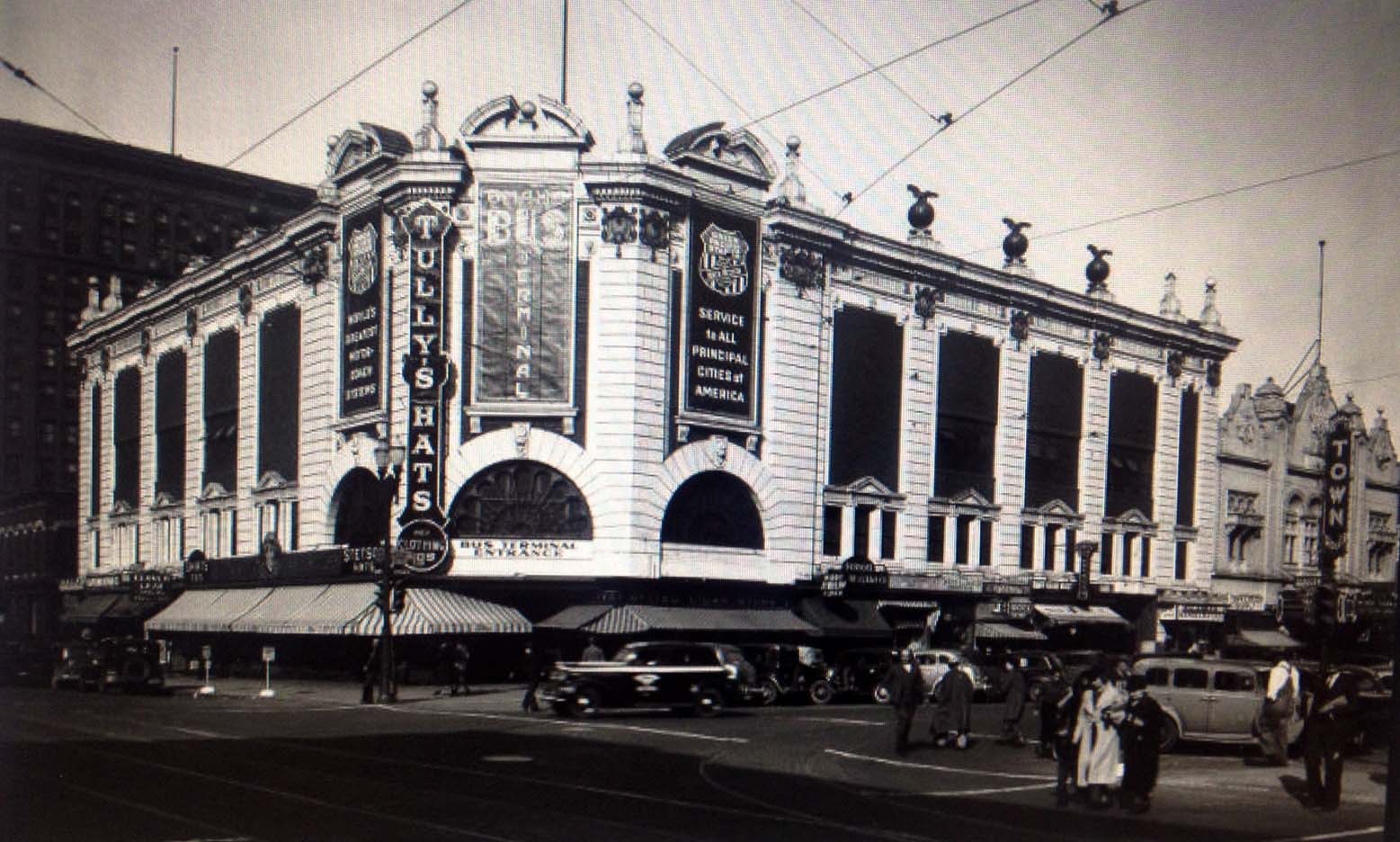 The Burlington Trailways showing the Clover Leaf Club. (Photo courtesy of the Bostwick-Frohardt/KM3TV Photography Collection at The Durham Museum Photo Archive).
The Burlington Trailways showing the Clover Leaf Club. (Photo courtesy of the Bostwick-Frohardt/KM3TV Photography Collection at The Durham Museum Photo Archive).
 Detail of the Clover Leaf Club entrance. Miss Cassette just adores this neon sign wedged between these awnings. I imagine a descending stairwell similar to King Fong Cafe’s.
Detail of the Clover Leaf Club entrance. Miss Cassette just adores this neon sign wedged between these awnings. I imagine a descending stairwell similar to King Fong Cafe’s.
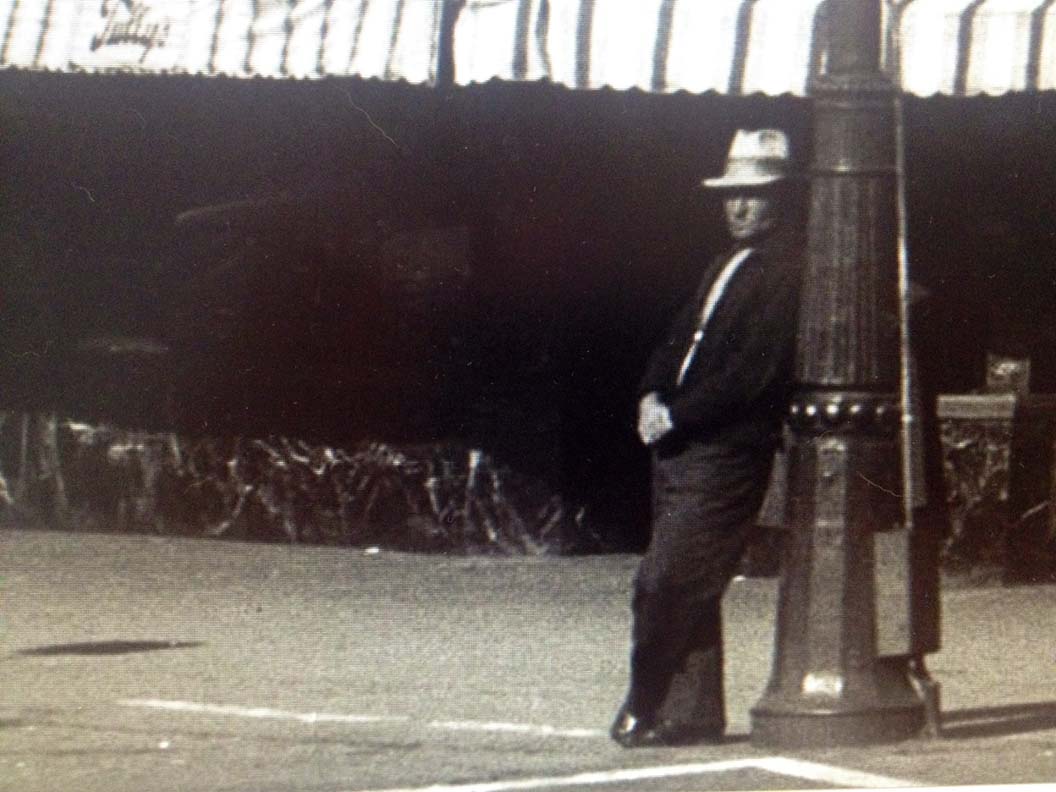
Detail of the hinky guy by the street lamp on Douglas Street that you might have missed. But he didn’t miss you.
A Long Series of Unfortunate Events
The Omaha World Herald began covering the action at the Clover Leaf Club with almost a lecherous frequency, which I supposed was telling of the times. This was not the only club in town being written about. Numerous nightclubs and hotels were the scene of games of chance. In particular I noticed the name the Merriam Hotel with frequency. In one article Mrs. Mae Pruss, proprietor of the Merriam Hotel, merely wanted to clear up that Dutch Volker, who had been arrested in yet another Clover Leaf Club raid, did not live at the Merriam. “The Morals Squad” began raiding and nabbing left and right. I began to see a rise of women being arrested, as well. Dice, dice boxes and tables were also taken in as evidence.
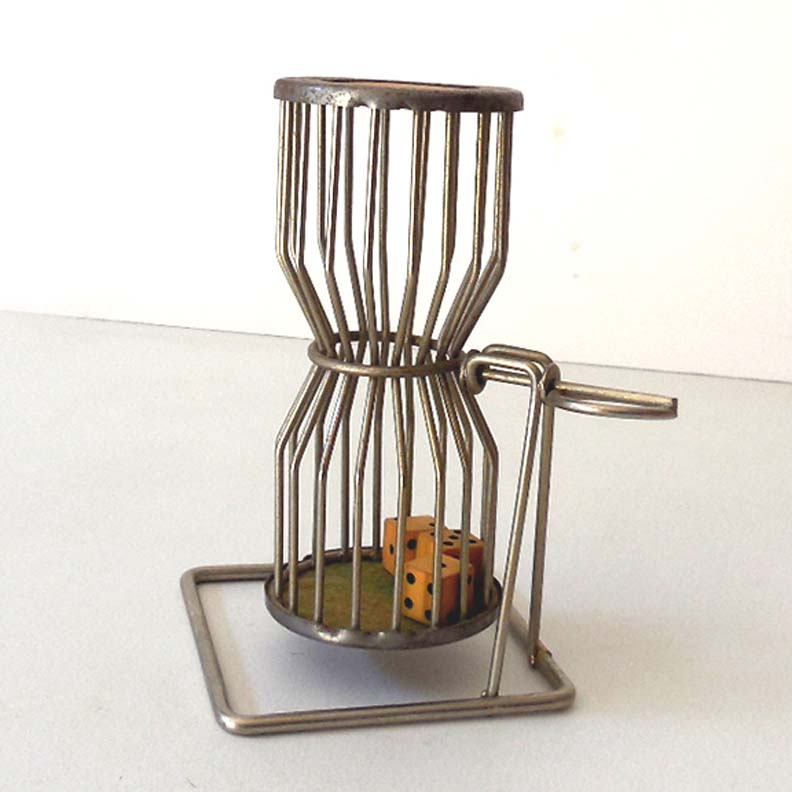
An example of a 1930s gambling Chuck-A-Luck dice cage.
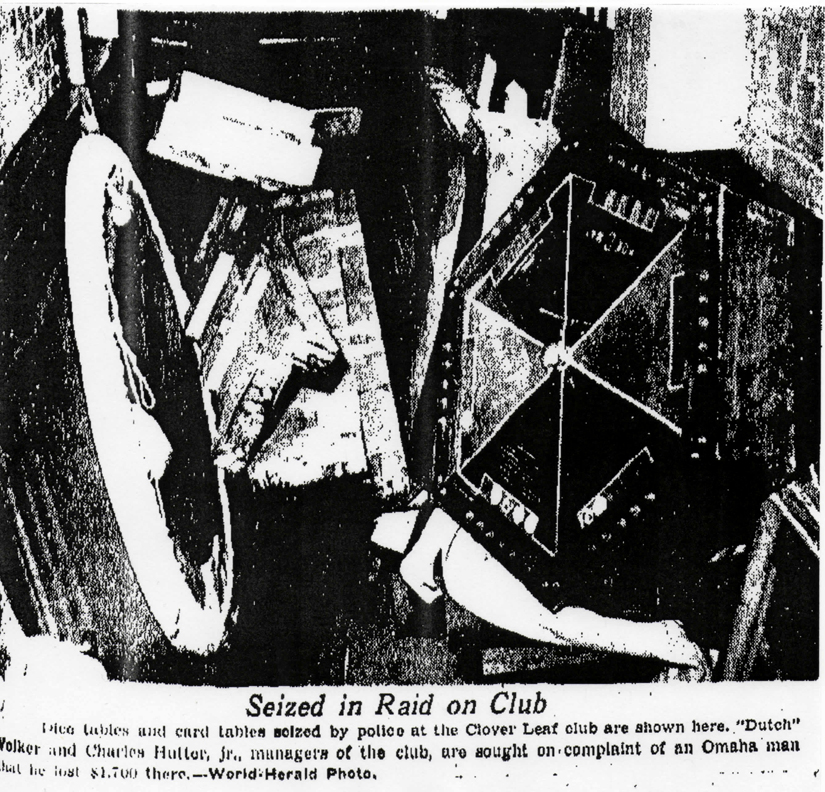
March 8, 1937 Tables seized in raid. The Horror!
At some point in 1937, Charles Hutter Jr, became a manager at the Clover Leaf Club, as a face of the company along with Dutch Volker. Charles Hutter Sr. and Dutch Volker continued on as holders. In this time period Jr. was named “Snooks,” perhaps for the billiard sport. The local papers also began calling him “Young Hutter,” which I thought was pretty sweet.
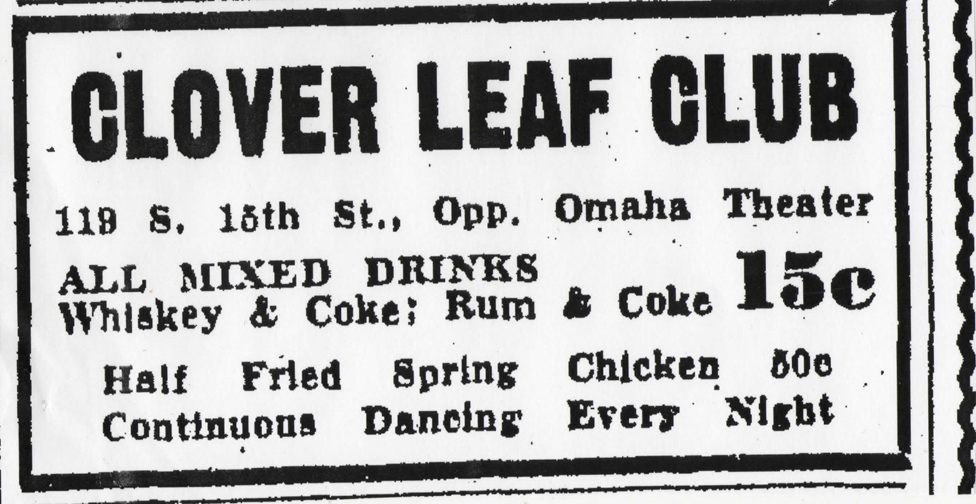
15 cents!
January of 1937 found Charles Hutter Sr. in trouble again when his liquor license was suspended. In a raucous little article of February 10, 1937, I snorted at the headline “Woman Hits Officer Over Head with Shoe During Street Melee.” In the wee morning hours two couples were asked to leave the Clover Leaf Club as it was way past everyone’s bedtime and more importantly, it was past closing hour. A policeman asked the drunken couples to move along and a fight ensued. “A woman pounded a policeman’s head with her shoe while her husband and his brother fought that officer.” I like to imagine the shoe that did the pounding as 1930s women’s shoes are my absolute favorites. I will not include her name on the slim chance that this might be your lovely grandmother on a rare night. In a later article I read that the two men were prominent Omaha druggists who had been “in a fight with the morals squad officers.”
 Charles Hutter Jr. George “Dutch” Volker
Charles Hutter Jr. George “Dutch” Volker
March 9, 1937. “WANTED: George ‘Dutch’ Volker, above and Charles Hutter Jr., were sought by police Monday for questioning about the complaint of an Omahan that he lost $1,700 gambling in the Clover Leaf Club, of which they are managers. Young Hutter, arrested last week on another charge, was found to be carrying dice that police said were “not square.” Not square! I love it. To make matters worse, the box of dice were also said to have been stamped with a cloverleaf. These were among some of the very best stories that I found. Marcus Hutter, Young Hutter’s uncle, Sr.’s brother, again made an appearance when he furnished a thousand dollar bond on Young Hutter’s concealed weapons charge.
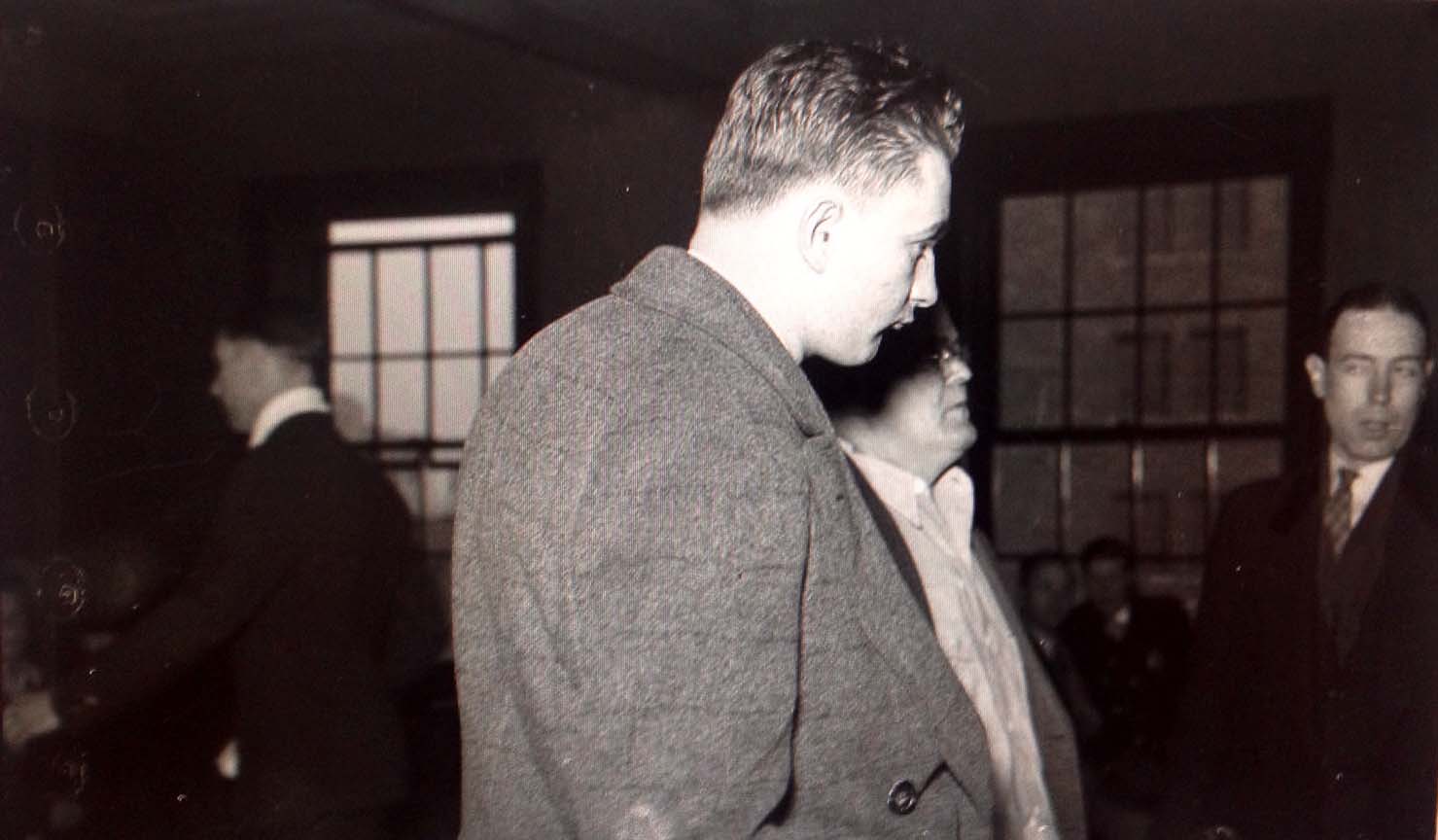
Charles Hutter, Jr. on the left and Dutch Volker on the right in what looks like hot water (court.)
By this time the Clover Leaf Club and Young Hutter were being collared over and over. In March 12, 1937, Young Hutter was quoted as asking the Morals Squad Officers, “What the pinch for this time?” That time it was ordinance 10,444: selling soft drinks without a license. In a lucky break, the judge dismissed Young Hutter for selling soft drinks but within months suspended Hutter Sr.’s license for 15 days. Months later Charles Hutter Sr. was again in court but this time for the big gaming trial. The alleged gaming equipment and tables had been seized in an earlier raid. Hutter Sr. testified that he had bought the club but denied having ever owned or used the gambling equipment seized in the raid. He also blamed unknown storage spaces and rooms adjoining the club “to which entrance can be made only through the club. He said that several months after buying the club he did not look into the storage room where the seized equipment was found.”
Under New Management
Come May 29, 1937 Charles Hutter Sr., Dutch Volker and Young Hutter packed up and moved on from the Clover Leaf Club. Fred Barnes, also known as “Tiny,” became the new owner. He also owned a bar at 203 S. 19th Street. Einar Abramson was also involved in the running of the Clover Leaf Club. Coincidently in June of 1937, I discovered that Charles Hutter Sr. applied for new liquor license for his newest location, 2320 N. street, formerly occupied by, you guessed it, a cigar store: Hupp Cigar Store.
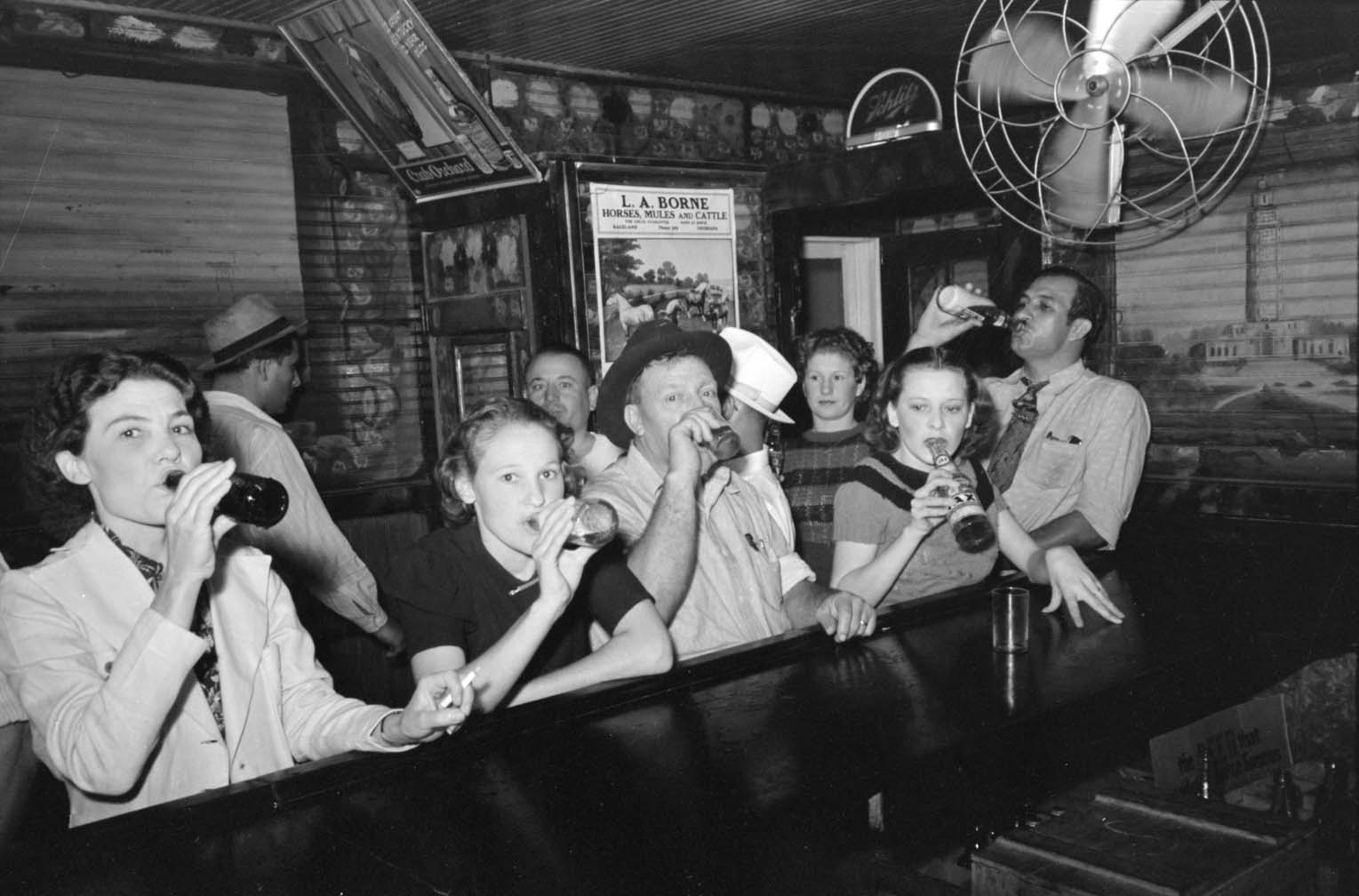
This photo depicts men and women drinking beer at a bar in Louisiana, during this time period. Pre-Prohibition saloons were mostly male establishments; post-Prohibition bars catered to both males and females. I just love this place.
I located countless ads promoting the Clover Leaf Club “under new management.” Perhaps in an attempt to bring in new customers or to distance themselves from the Morals Squad, the advertising did not seem to work. By September 29, 1937: Fred “Tiny” Barnes was up on charges stemming from a Liquor Raid and had to go before the liquor commission. By October 1, 1937, Fred “Tiny” Barnes and the Clover Leaf Club liquor license was suspended.
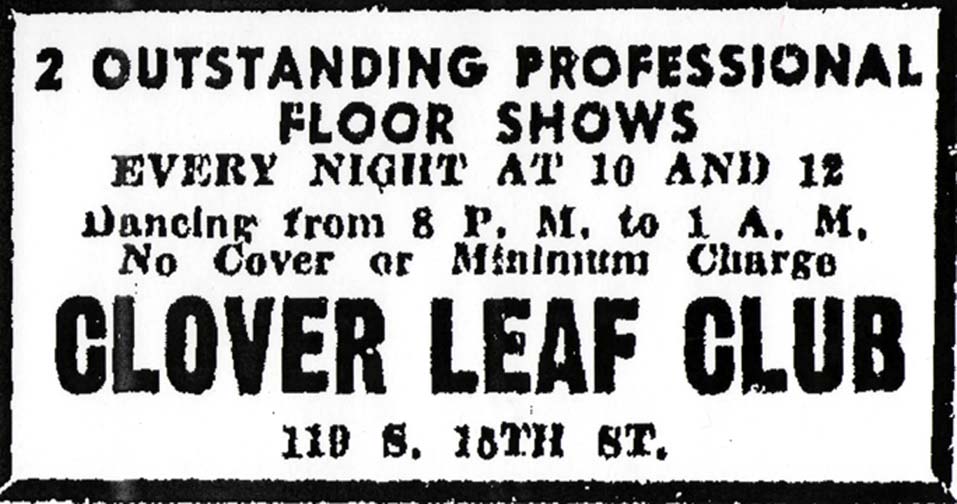
April 3, 1938. “Two outstanding professional floor shows.”
Let it be known that Tiny Barnes and Einar Abramson really liked their burlesque shows and performers. It didn’t seem like the focus was as much on couples dancing in these times as watching dancing groups perform. I got the idea Al Fanelli’s Clover Leaf Club Orchestra was a big deal. In October of 1938 I found an intriguing article titled “Impersonators Get $25 Fines.” Reportedly four member of the cast of the female impersonation floorshow at the Clover Leaf Club were fined and charged with indecent conduct and “wearing clothing of the opposite sex.” Oh my. Unbeknownst to me, female impersonators were quite popular in the 1930s and 1940s.
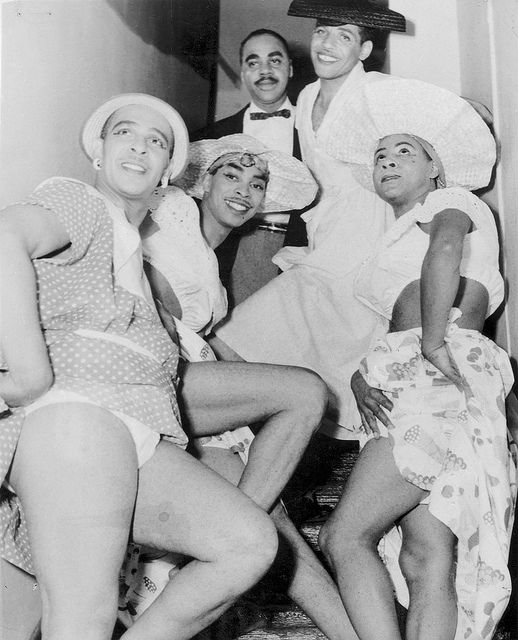
These beauties are an example of the 1930’s female impersonators from the era. These entertainers were a vital part of Bronzeville’s jazz and cabaret scene—not from Omaha but glorious.
A little to abruptly for me, I found a small ad from Jan 27, 1939, simply stated, “Clover Leaf Club closing; must sell equipment, chairs, tables, safe, etc. Reasonable. 119 S. 15th Street.” Was it odd to feel sad?
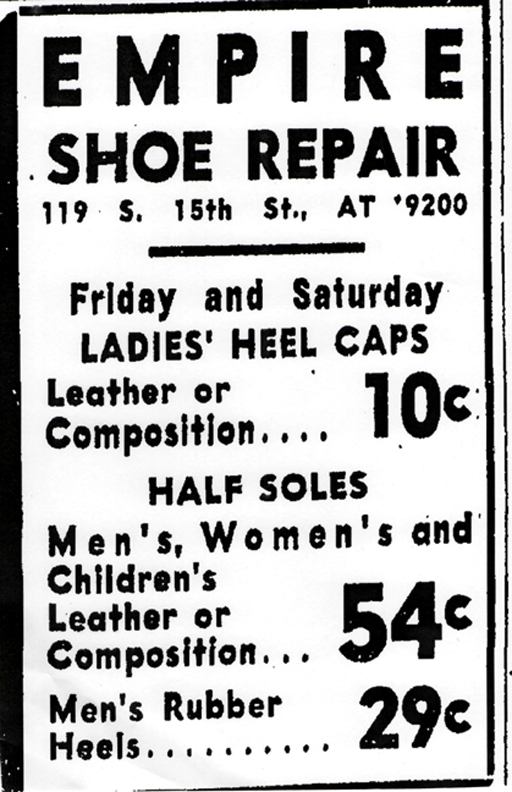
By January 18, 1940, 119 S. 15th Street had become Empire Shoes. It is hard to imagine all of that glory becoming a shoe store. They must have had so much room. It must have been very chiche. Maybe it was a front? See what sleuthing in the underworld has done to my mind? Empire Shoes had a short-lived enterprise because the city directory revealed the location went vacant for four years until 1945 when the Dick Ragdale Café opened up. In 1946 it became the G.I. Club and later still, the One Nineteen Café and Billiards.
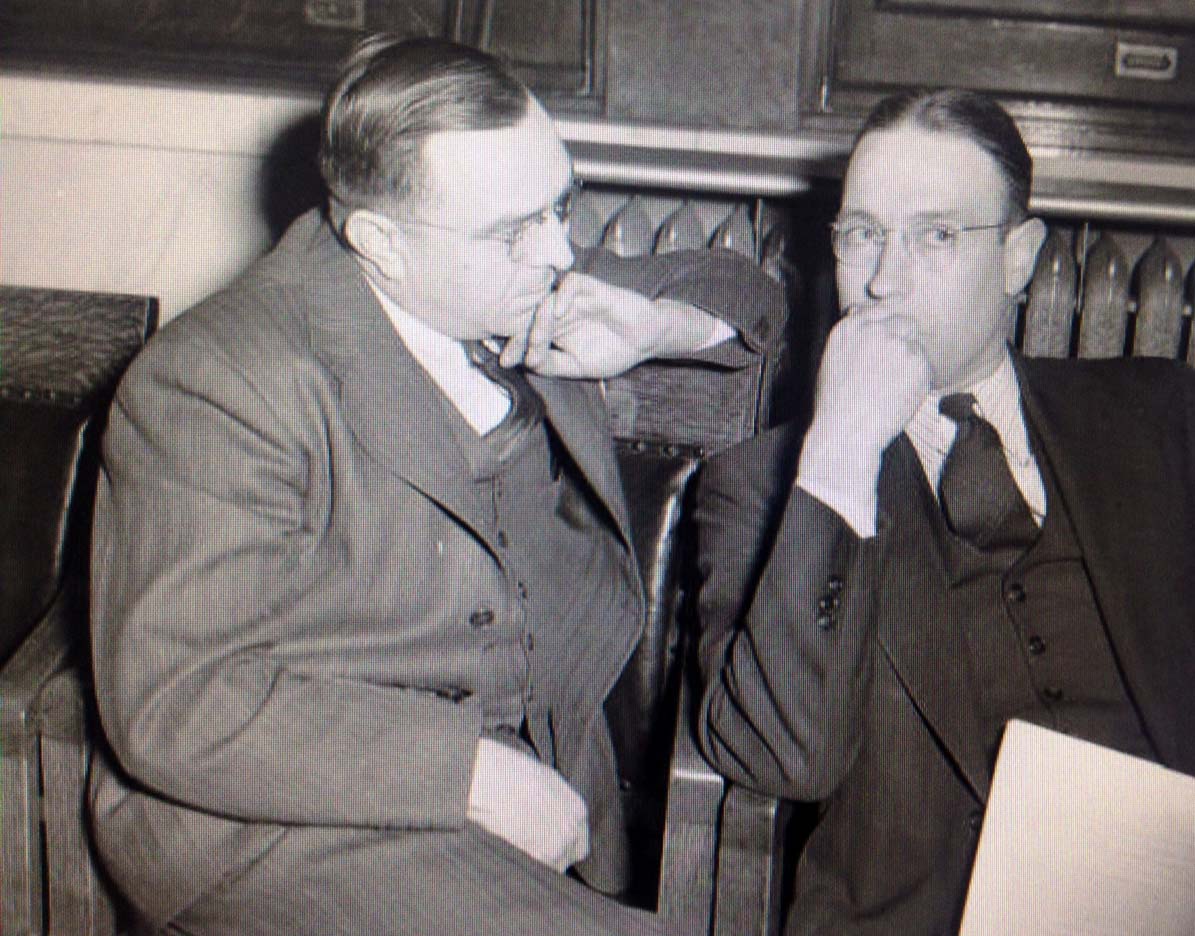
But the fun continued for George “Dutch” Volker. Here he is in court, with what appears to be his attorney. A true trailblazer. What a character he was.
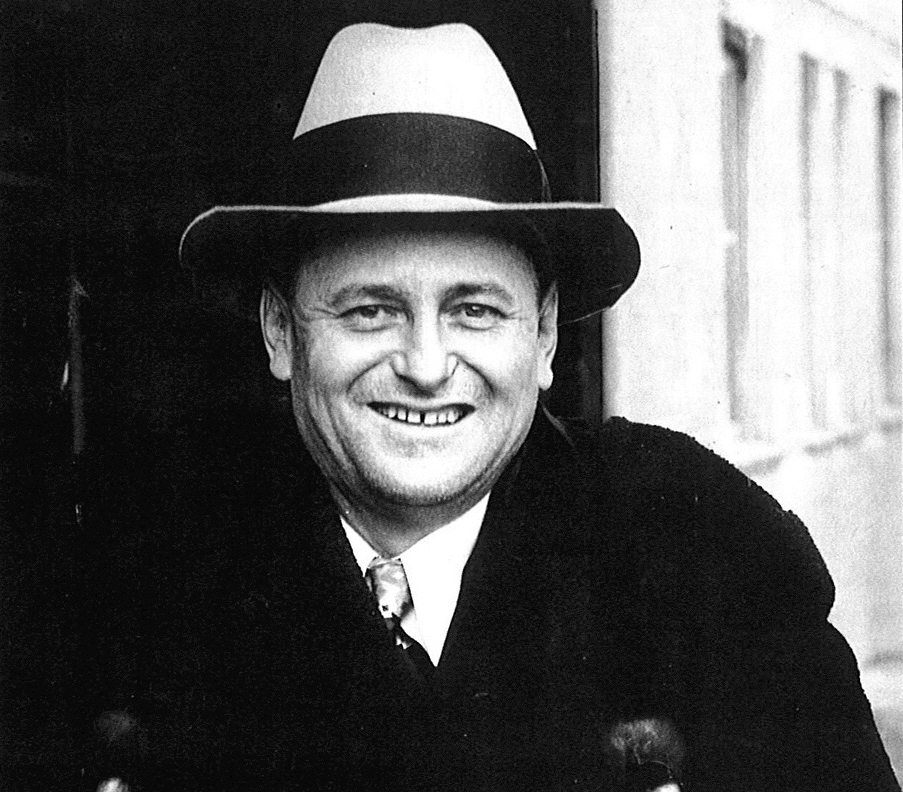
And the adventure continued for Charles Hutter Sr. Here he is seen on his crutches. The genial proprietor of the Clover Leaf Club, enjoyed notoriety because of the numerous assassination attempts made by liquor racketeers during the Prohibition Era.
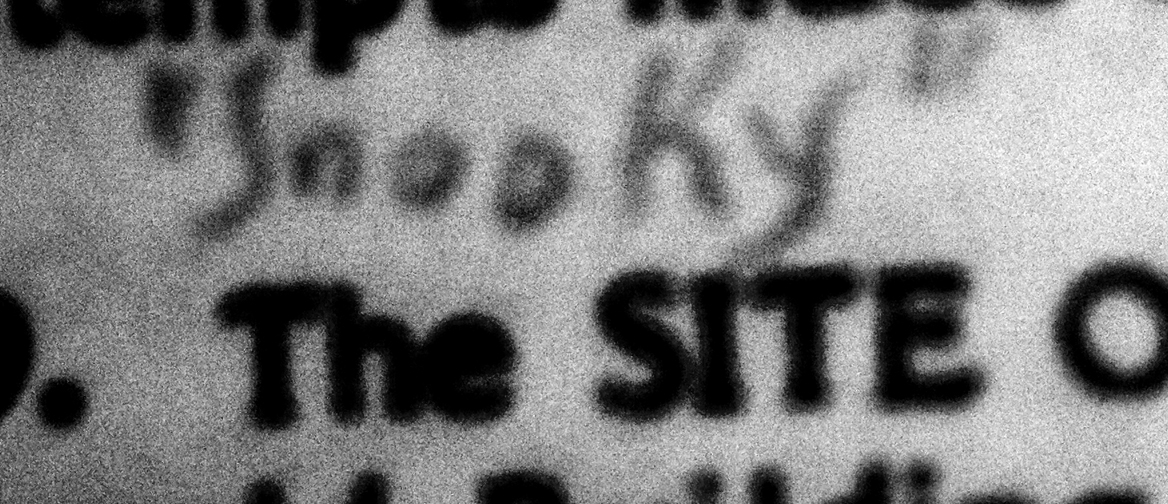
Snooks would go on to lead quite the colorful life. Would you expect anything less? He moved down to Daytona Beach, Florida and was rumored to have made his way to Las Vegas in the 1970s. (Which reminds me, if you want to read the most incredible book about the Omaha underground, check out Cigars and Wires by Jon Blecha. I only discovered it near the end of my research for this story. All of the amazing details of underground cigar shop culture. If you call 402-502-0514 and are in town, he will supposedly deliver it right to your door.)
The Rialto Theater building, home to the Pickwick Greyhound Lines, the Burlington Bus Lines and Union Pacific Bus stations, a bowling alley, numerous retail stores such as Tully’s and Natelson’s, various cafeterias and restaurants and of course the once glorious Clover Leaf Club was razed in February of 1986. I would have loved to have seen it with my own eyes—that 70 degree forest glen grotto with a house orchestra beneath the shadows of the city, the nightlife, the lit buzzer linked to the tables and the cards in hidden rooms beyond, the beautiful performers and their costumes, all the snorts, smudgers, tomatoes and that hooch. The site was paved over for a parking lot and years later became the Union Pacific Center we know today.
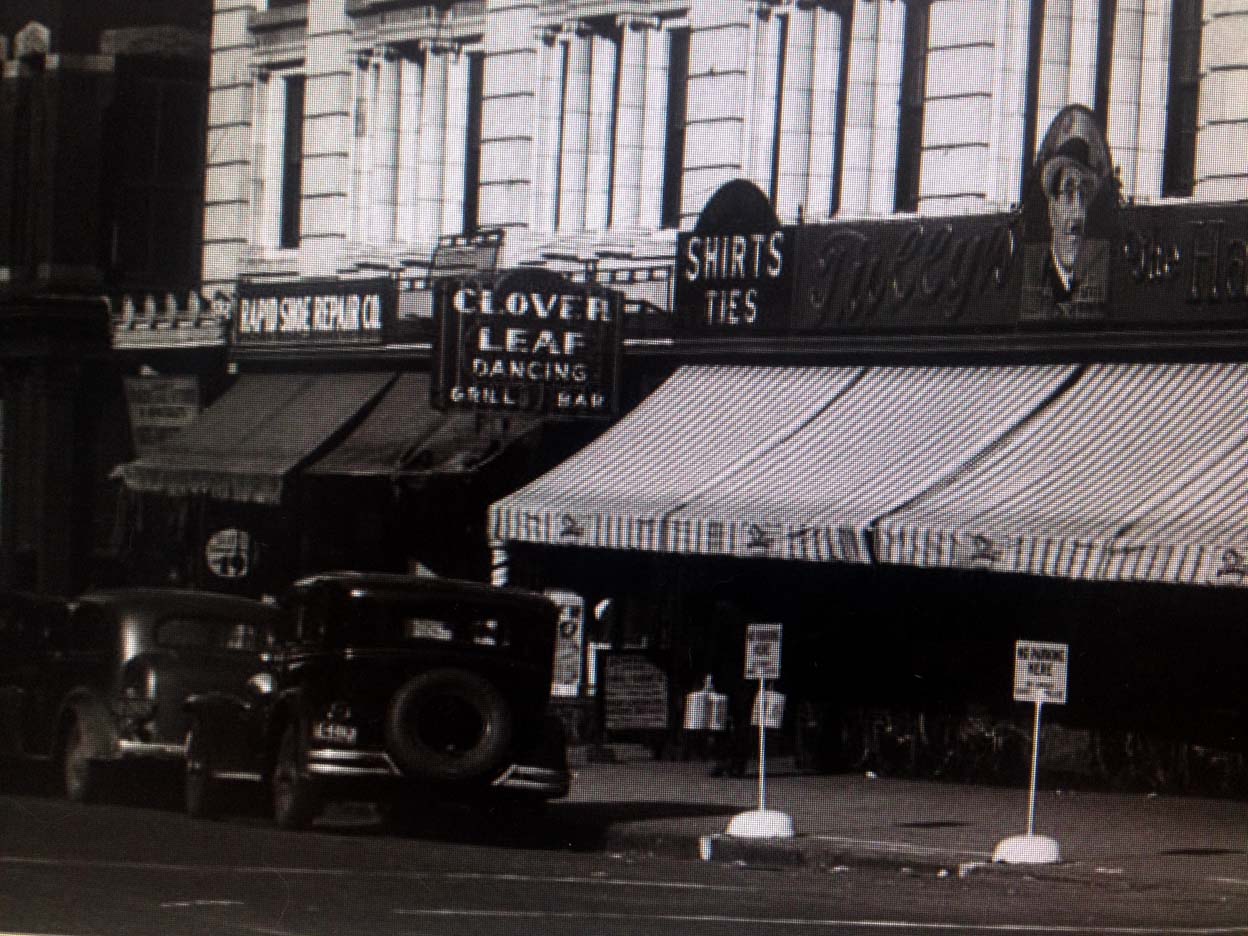
Thank you so much for spending the time to read this article. I had such a good time researching this one. If you would like to comment on this part of town, the glorious buildings or the incredible people who shaped our city, please click on the header to enable comments. If you would like to write me personally, please do so at myomahaobsession@yahoo.com. Get out and walk around, if you can, down on 15th and Douglas this week.
© Miss Cassette and myomahaobsession, 2016. Unauthorized use and/or duplication of this material without express and written permission from this site’s author and/or owner is strictly prohibited. Excerpts and links may be used, provided that full and clear credit is given to Miss Cassette and myomahaobsession with appropriate and specific direction to the original content.

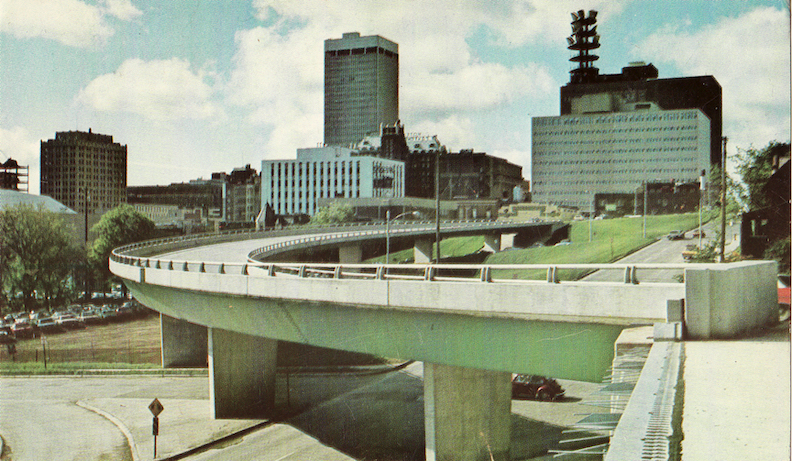

Tullys was around until at least the early to mid 60s. I have a few suits from that era with the Tullys label.
I enjoy your site once in awhile. My great uncle FRANK JANICEK was the business manager of the Bell Cigar Store at 109 S. 15th Street in the Frenzer Block. It had back room gambling room and access to the infamous Bell Hotel that faced Douglas Street and the old Union Pacific headquarters. I miss Omaha as it used to be. It was wide open while Lincoln was goody-two-shoe. Omaha was the GATE CITY and Lincoln was the HOLY CITY nigh unto BETHANY. I used to work for Greyhound in Omaha in the early 1990s. I was born in Omaha and much of my late extended family lived there.
I love the details you have shared. Thank you so much. Feel free to chime it whenever you are inspired to comment on the old Omaha. Take care.
Miss Cassette, your coverage of the Clover Leaf and ‘other such establishments’ I found to be nothing short of wonderful! And it reminded me of what my father told me about a certain uncle I had only met twice in my life; one of those times being when I was apparently only months old. Dad’s uncle “Billy” Fox ran a cigar store too! It was located in various places (cigar stores moved quite often I was told) but his last ‘sports parlor was on 15th & Howard. Someone tried to set fire to it once and failed. You will find mention of my uncle Billy Fox in the “Cigars and Wires” book you mentioned. He was quite a colorful man in his day alright!
I am obsessed with Billy Fox. You must not have found it yet, but he has a starring role in another investigation on this site. You will hopefully find him shortly!
So this is random. I wanted to look up the house that I grew up in and it led me to this site. I lived for 22 years at 4429 s. 18th street!!! I remember hearing stories from older neighbors about my house being apart of crazy activity but never really believing it. Also, once someone told me that someone was shot and crawled to the small alley. way between the wall and the house, I always though they were just trying to scare me. Its really cool because now I teach history!!!
Very very cool! I am so glad you wrote in. I love when people eventually make the connection and find, hopefully, some new and interesting history they didn’t know about their old house or family member. It means the world to me that you would reach out and let me know you found it! I’m sure you have Stories Of your own to tell. Please take care.